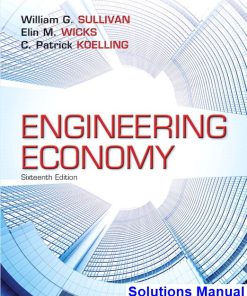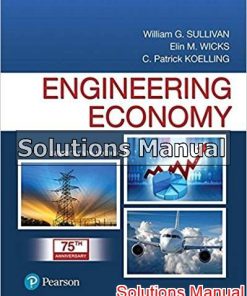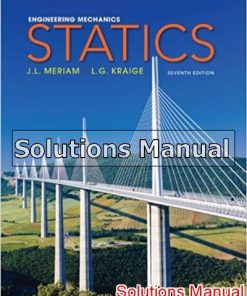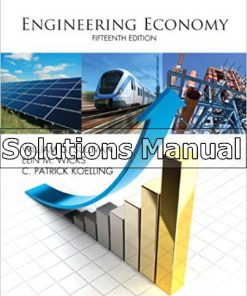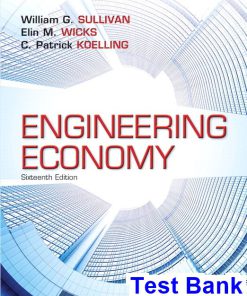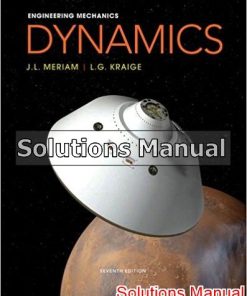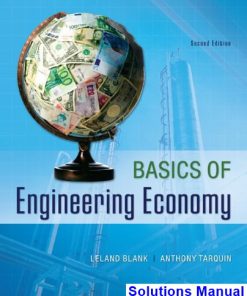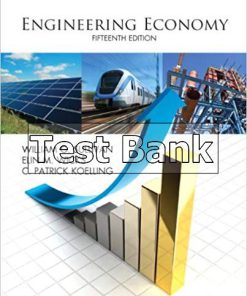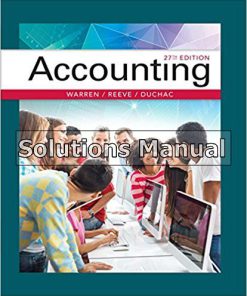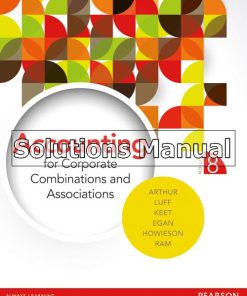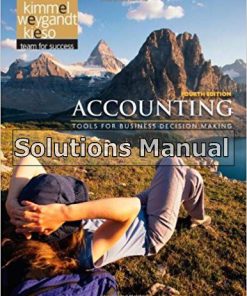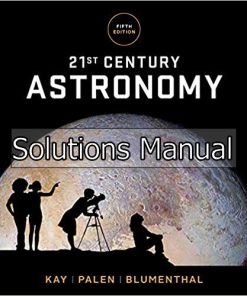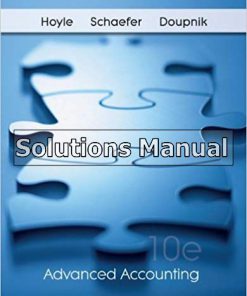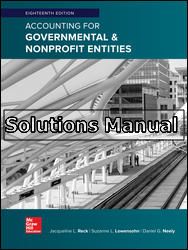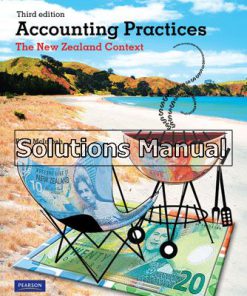Engineering Economy 7th Edition Blank Solutions Manual
$50.00 Original price was: $50.00.$26.50Current price is: $26.50.
Engineering Economy 7th Edition Blank Solutions Manual.
Engineering Economy 7th Edition Blank Solutions Manual
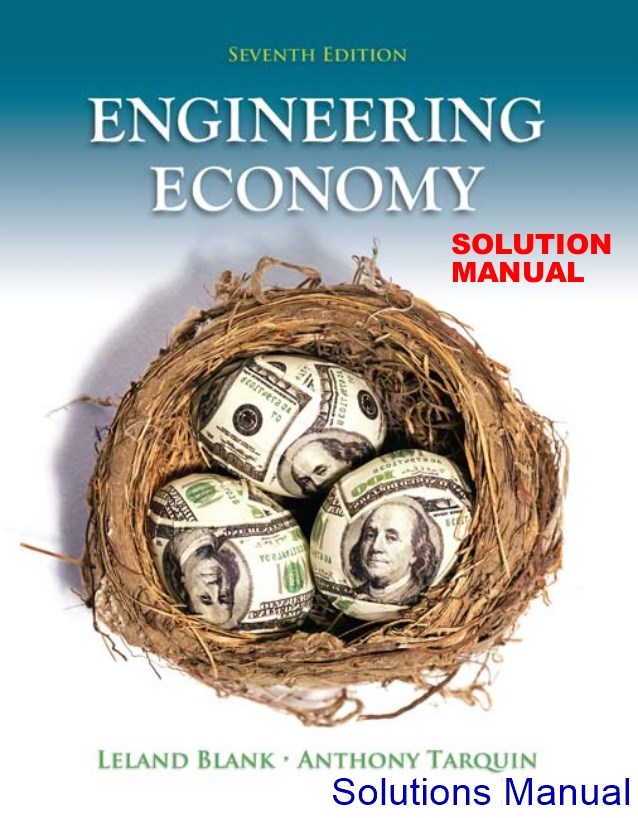
Product details:
- ISBN-10 : 0073376302
- ISBN-13 : 978-0073376301
- Author:
Engineering Economy, 7th edition, presents a crisp, bold new design using color, highlighting and icons to focus on important concepts, terms, equations and decision guidelines. There are new features, new topics (such as ethics and staged decision making), and new online tools; yet no compromise on coverage, examples, or the well-accepted writing style of this popular text. The preface provides an overview of What’s New and graphically depicts resources for Instructors and Students. Solved examples, problems and case studies target many of the current engineering challenges in areas such as energy, ethics, the environment, and the world’s changing economics. Approximately eighty percent of the end-of-chapter problems are revised or new for this edition.
Table contents:
- LEARNING STAGE 1. THE FUNDAMENTALS
- Chapter 1. Foundations of Engineering Economy
- 1.1. Engineering Economics: Description and Role in Decision Making
- 1.2. Performing an Engineering Economy Study
- 1.3. Professional Ethics and Economic Decisions
- 1.4. Interest Rate and Rate of Return
- 1.5. Terminology and Symbols
- 1.6. Cash Flows: Estimation and Diagramming
- 1.7. Economic Equivalence
- 1.8. Simple and Compound Interest
- 1.9. Minimum Attractive Rate of Return
- 1.10. Introduction to Spreadsheet Use
- Chapter Summary
- Problems
- Additional Problems and FE Exam Review Questions
- Case Study—Renewable Energy Sources for Electricity Generation
- Case Study—Refrigerator Shells
- Chapter 2. Factors: How Time and Interest Affect Money
- PE The Cement Factory Case
- 2.1. Single-Amount Factors (F/P and P/F)
- 2.2. Uniform Series Present Worth Factor and Capital Recovery Factor (P/A and A/P)
- 2.3. Sinking Fund Factor and Uniform Series Compound Amount Factor (A/F and F/A)
- 2.4. Factor Values for Untabulated i or n Values
- 2.5. Arithmetic Gradient Factors (P/G and A/G)
- 2.6. Geometric Gradient Series Factors
- 2.7. Determining i or n for Known Cash Flow Values
- Chapter Summary
- Problems
- Additional Problems and FE Exam Review Questions
- Case Study—Time Marches On; So Does the Interest Rate
- Chapter 3. Combining Factors and Spreadsheet Functions
- 3.1. Calculations for Uniform Series That Are Shifted
- 3.2. Calculations Involving Uniform Series and Randomly Placed Single Amounts
- 3.3. Calculations for Shifted Gradients
- Chapter Summary
- Problems
- Additional Problems and FE Exam Review Questions
- Case Study—Preserving Land for Public Use
- Chapter 4. Nominal and Effective Interest Rates
- PE The Credit Card Offer Case
- 4.1. Nominal and Effective Interest Rate Statements
- 4.2. Effective Annual Interest Rates
- 4.3. Effective Interest Rates for Any Time Period
- 4.4. Equivalence Relations: Payment Period and Compounding Period
- 4.5. Equivalence Relations: Single Amounts with PP ≥ CP
- 4.6. Equivalence Relations: Series with PP ≥ CP
- 4.7. Equivalence Relations: Single Amounts and Series with PP < CP
- 4.8. Effective Interest Rate for Continuous Compounding
- 4.9. Interest Rates That Vary over Time
- Chapter Summary
- Problems
- Additional Problems and FE Exam Review Questions
- Case Study—Is Owning a Home a Net Gain or Net Loss over Time?
- LEARNING STAGE 2. BASIC ANALYSIS TOOLS
- Chapter 5. Present Worth Analysis
- PE Water for Semiconductor Manufacturing Case
- 5.1. Formulating Alternatives
- 5.2. Present Worth Analysis of Equal-Life Alternatives
- 5.3. Present Worth Analysis of Different-Life Alternatives
- 5.4. Future Worth Analysis
- 5.5. Capitalized Cost Analysis
- Chapter Summary
- Problems
- Additional Problems and FE Exam Review Questions
- Case Study—Comparing Social Security Benefits
- Chapter 6. Annual Worth Analysis
- 6.1. Advantages and Uses of Annual Worth Analysis
- 6.2. Calculation of Capital Recovery and AW Values
- 6.3. Evaluating Alternatives by Annual Worth Analysis
- 6.4. AW of a Permanent Investment
- 6.5. Life-Cycle Cost Analysis
- Chapter Summary
- Problems
- Additional Problems and FE Exam Review Questions
- Case Study—The Changing Scene of an Annual Worth Analysis
- Chapter 7. Rate of Return Analysis: One Project
- 7.1. Interpretation of a Rate of Return Value
- 7.2. Rate of Return Calculation Using a PW or AW Relation
- 7.3. Special Considerations When Using the ROR Method
- 7.4. Multiple Rate of Return Values
- 7.5. Techniques to Remove Multiple Rates of Return
- 7.6. Rate of Return of a Bond Investment
- Chapter Summary
- Problems
- Additional Problems and FE Exam Review Questions
- Case Study—Developing and Selling an Innovative Idea
- Chapter 8. Rate of Return Analysis: Multiple Alternatives
- 8.1. Why Incremental Analysis Is Necessary
- 8.2. Calculation of Incremental Cash Flows for ROR Analysis
- 8.3. Interpretation of Rate of Return on the Extra Investment
- 8.4. Rate of Return Evaluation Using PW: Incremental and Breakeven
- 8.5. Rate of Return Evaluation Using AW
- 8.6. Incremental ROR Analysis of Multiple Alternatives
- 8.7. All-in-One Spreadsheet Analysis (Optional)
- Chapter Summary
- Problems
- Additional Problems and FE Exam Review Questions
- Case Study—ROR Analysis with Estimated Lives That Vary
- Case Study—How a New Engineering Graduate Can Help His Father
- Chapter 9. Benefit/Cost Analysis and Public Sector Economics
- PE Water Treatment Facility #3 Case
- 9.1. Public Sector Projects
- 9.2. Benefit/Cost Analysis of a Single Project
- 9.3. Alternative Selection Using Incremental B/C Analysis
- 9.4. Incremental B/C Analysis of Multiple, Mutually Exclusive Alternatives
- 9.5. Service Sector Projects and Cost-Effectiveness Analysis
- 9.6. Ethical Considerations in the Public Sector
- Chapter Summary
- Problems
- Additional Problems and FE Exam Review Questions
- Case Study—Comparing B/C Analysis and CEA of Traffic Accident Reduction
- LEARNING STAGE 2. EPILOGUE: SELECTING THE BASIC ANALYSIS TOOL
- LEARNING STAGE 3. MAKING BETTER DECISIONS
- Chapter 10. Project Financing and Noneconomic Attributes
- 10.1. MARR Relative to the Cost of Capital
- 10.2. Debt-Equity Mix and Weighted Average Cost of Capital
- 10.3. Determination of the Cost of Debt Capital
- 10.4. Determination of the Cost of Equity Capital and the MARR
- 10.5. Effect of Debt-Equity Mix on Investment Risk
- 10.6. Multiple Attribute Analysis: Identification and Importance of Each Attribute
- 10.7. Evaluation Measure for Multiple Attributes
- Chapter Summary
- Problems
- Additional Problems and FE Exam Review Questions
- Case Study—Which Is Better—Debt or Equity Financing?
- Chapter 11. Replacement and Retention Decisions
- PE Keep or Replace the Kiln Case
- 11.1. Basics of a Replacement Study
- 11.2. Economic Service Life
- 11.3. Performing a Replacement Study
- 11.4. Additional Considerations in a Replacement Study
- 11.5. Replacement Study over a Specified Study Period
- 11.6. Replacement Value
- Chapter Summary
- Problems
- Additional Problems and FE Exam Review Questions
- Case Study—Will the Correct ESL Please Stand?
- Chapter 12. Independent Projects with Budget Limitation
- 12.1. An Overview of Capital Rationing among Projects
- 12.2. Capital Rationing Using PW Analysis of Equal-Life Projects
- 12.3. Capital Rationing Using PW Analysis of Unequal-Life Projects
- 12.4. Capital Budgeting Problem Formulation Using Linear Programming
- 12.5. Additional Project Ranking Measures
- Chapter Summary
- Problems
- Additional Problems and FE Exam Review Questions
- Chapter 13. Breakeven and Payback Analysis
- 13.1. Breakeven Analysis for a Single Project
- 13.2. Breakeven Analysis Between Two Alternatives
- 13.3. Payback Analysis
- 13.4. More Breakeven and Payback Analysis on Spreadsheets
- Chapter Summary
- Problems
- Additional Problems and FE Exam Review Questions
- Case Study—Water Treatment Plant Process Costs
- LEARNING STAGE 4. ROUNDING OUT THE STUDY
- Chapter 14. Effects of Inflation
- 14.1. Understanding the Impact of Inflation
- 14.2. Present Worth Calculations Adjusted for Inflation
- 14.3. Future Worth Calculations Adjusted for Inflation
- 14.4. Capital Recovery Calculations Adjusted for Inflation
- Chapter Summary
- Problems
- Additional Problems and FE Exam Review Questions
- Case Study—Inflation versus Stock and Bond Investments
- Chapter 15. Cost Estimation and Indirect Cost Allocation
- 15.1. Understanding How Cost Estimation Is Accomplished
- 15.2. Unit Method
- 15.3. Cost Indexes
- 15.4. Cost-Estimating Relationships: Cost-Capacity Equations
- 15.5. Cost-Estimating Relationships: Factor Method
- 15.6. Traditional Indirect Cost Rates and Allocation
- 15.7. Activity-Based Costing (ABC) for Indirect Costs
- 15.8. Making Estimates and Maintaining Ethical Practices
- Chapter Summary
- Problems
- Additional Problems and FE Exam Review Questions
- Case Study—Indirect Cost Analysis of Medical Equipment Manufacturing Costs
- Case Study—Deceptive Acts Can Get You in Trouble
- Chapter 16. Depreciation Methods
- 16.1. Depreciation Terminology
- 16.2. Straight Line (SL) Depreciation
- 16.3. Declining Balance (DB) and Double Declining Balance (DDB) Depreciation
- 16.4. Modified Accelerated Cost Recovery System (MACRS)
- 16.5. Determining the MACRS Recovery Period
- 16.6. Depletion Methods
- Chapter Summary
- Chapter 16 Appendix
- 16A.1. Sum-of-Years-Digits (SYD) and Unit-of-Production (UOP) Depreciation
- 16A.2. Switching between Depreciation Methods
- 16A.3. Determination of MACRS Rates
- Problems
- Additional Problems and FE Exam Review Questions
- Appendix Problems
- Chapter 17. After-Tax Economic Analysis
- 17.1. Income Tax Terminology and Basic Relations
- 17.2. Calculation of Cash Flow after Taxes
- 17.3. Effect on Taxes of Different Depreciation Methods and Recovery Periods
- 17.4. Depreciation Recapture and Capital Gains (Losses)
- 17.5. After-Tax Evaluation
- 17.6. After-Tax Replacement Study
- 17.7. After-Tax Value-Added Analysis
- 17.8. After-Tax Analysis for International Projects
- 17.9. Value-Added Tax
- Chapter Summary
- Problems
- Additional Problems and FE Exam Review Questions
- Case Study—After-Tax Analysis for Business Expansion
- Chapter 18. Sensitivity Analysis and Staged Decisions
- 18.1. Determining Sensitivity to Parameter Variation
- 18.2. Sensitivity Analysis Using Three Estimates
- 18.3. Estimate Variability and the Expected Value
- 18.4. Expected Value Computations for Alternatives
- 18.5. Staged Evaluation of Alternatives Using a Decision Tree
- 18.6. Real Options in Engineering Economics
- Chapter Summary
- Problems
- Additional Problems and FE Exam Review Questions
- Case Study—Sensitivity to the Economic Environment
- Case Study—Sensitivity Analysis of Public Sector Projects—Water Supply Plans
- Chapter 19. More on Variation and Decision Making under Risk
- 19.1. Interpretation of Certainty, Risk, and Uncertainty
- 19.2. Elements Important to Decision Making under Risk
- 19.3. Random Samples
- 19.4. Expected Value and Standard Deviation
- 19.5. Monte Carlo Sampling and Simulation Analysis
- Chapter Summary
- Problems
- Additional Problems and FE Exam Review Questions
- Case Study—Using Simulation and Three-Estimate Sensitivity Analysis
- Appendix A Using Spreadsheets and Microsoft Excel©
- A.1. Introduction to Using Excel
- A.2. Organization (Layout) of the Spreadsheet
- A.3. Excel Functions Important to Engineering Economy (alphabetical order)
- A.4. Goal Seek—A Tool for Breakeven and Sensitivity Analysis
- A.5. Solver—An Optimizing Tool for Capital Budgeting, Breakeven, and Sensitivity Analysis
- A.6. Error Messages
- Appendix B Basics of Accounting Reports and Business Ratios
- B.1. The Balance Sheet
- B.2. Income Statement and Cost of Goods Sold Statement
- B.3. Business Ratios
- Appendix C Code of Ethics for Engineers
- Appendix D Alternate Methods for Equivalence Calculations
- D.1. Using Programmable Calculators
- D.2. Using the Summation of a Geometric Series
- Appendix E Glossary of Concepts and Terms
- E.1. Important Concepts and Guidelines
- E.2. Symbols and Terms
- Reference Materials
- Compound Interest Factor Tables
- Photo Credits
- Index
People also search:
engineering economy 7th edition
engineering economy 7th edition solution manual
engineering economy 7th edition solution
engineering economy 7th edition pdf
engineering economy examples
Instant download after Payment is complete
You may also like…
Solutions Manual
Solutions Manual
Engineering Mechanics Statics 7th Edition meriam Solutions Manual
Solutions Manual
Solutions Manual
Engineering Mechanics Dynamics 7th Edition Meriam Solutions Manual
Solutions Manual
Related products
Solutions Manual
Solutions Manual
Solutions Manual
Solutions Manual
Solutions Manual
Accounting For Governmental And Nonprofit Entities 18th Edition Reck Solutions Manual




